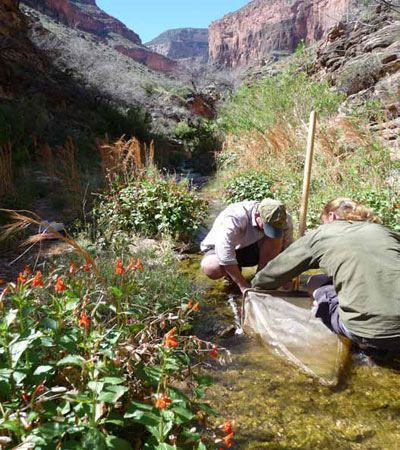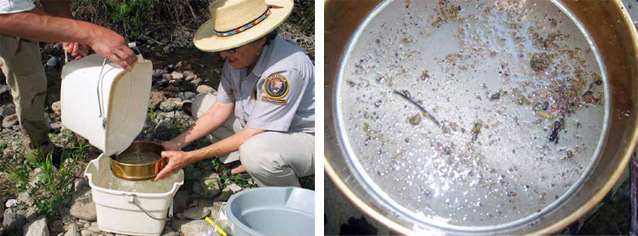
NPS
The utility of monitoring aquatic macroinvertebrates to investigate ecosystem health has long been recognized by ecologists who have used this technique to (1) assess the results of management actions implemented in a system (e.g. exotic species removal), (2) determine the effects of a pollutant on the system, and (3) monitor water quality compliance issues (Rosenberg and Resh 1993).
These organisms are the best indicators of freshwater ecosystem health for a number of reasons:
- They can exhibit a wide range of responses to changes in environmental conditions and stress because of the large variety of organisms that make up this group.
- They serve as excellent indicators of long and short-term change. Many species have long-lived life cycle stages that allow them to integrate effects of land and water use in the watershed, making them sensitive to changes in the physical and chemical environment (Scott et al. 2006; Maretet al. 2001).
- When combined with physical and chemical water assessment, aquatic macroinvertebrate monitoring provides a comprehensive evaluation of watershed condition (Karr 1991).
| Southern Plains Network |
| Chickasaw National Recreation Area |
| Lyndon B. Johnson National Historical Park |
| Pecos National Historical Park |
| Sonoran Desert Network |
| Gila Cliff Dwellings National Monument |
| Montezuma Castle National Monument |
| Organ Pipe Cactus National Monument |
| Saguaro National Park |
| Tumacacori National Historical Park |
| Tuzigoot National Monument |
| Southern Colorado Plateau Network |
| Bandelier National Monument |
| Canyon de Chelly National Monument |
| Glen Canyon National Recreation Area |
| Grand Canyon National Park |
| Mesa Verde National Park |
| Chihuahuan Desert Network |
| Amistad National Recreation Area |
| Big Bend National Park |
| Carlsbad Caverns National Park |
| Guadalupe Mountains National Park |
Macroinvertebrate monitoring is planned or underway in all of the National Park Service Inventory and Monitoring networks of the Southwest. The overall monitoring objectives include tracking changes in the composition and abundance of aquatic macroinvertebrate assemblages and in habitat condition.
We will also investigate relationships between aquatic macroinvertebrate indices and other network vital signs, such as fish communities, water quality and quantity, and stream channel morphology.
With monitoring data, park resource managers will be able to make more informed management decisions regarding aquatic resources within their parks. Network monitoring results are available online from the NPS Data Store.

NPS
For more information...
Learn about long-term monitoring of aquatic macroinvertebrates in
Chihuahan Desert Network parks:
https://science.nature.nps.gov/im/units/chdn/monitor/springs.cfm
Southern Colorado Plateau Network parks:
https://science.nature.nps.gov/im/units/scpn/monitor/macroInvert.cfm
Sonoran Desert Network parks:
https://science.nature.nps.gov/im/units/sodn/assets/docs/ProtocolDocs/PS_Streams.pdf
Prepared by Stacy Stumpf, Patty Valentine-Darby, and Evan Gwilliam, NPS Inventory and Monitoring Program, 2009.
Part of a series of articles titled Aquatic Macroinvertebrates in the American Southwest.
Last updated: May 5, 2015
